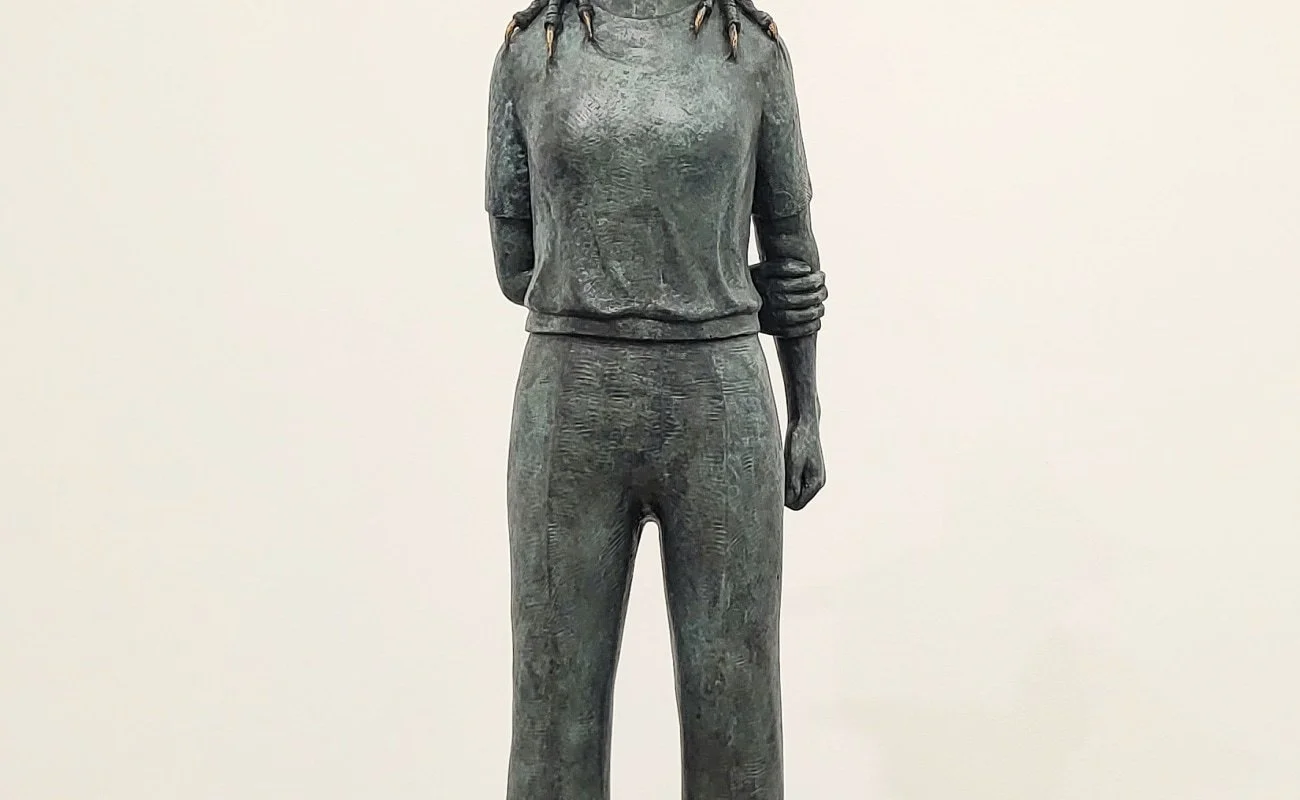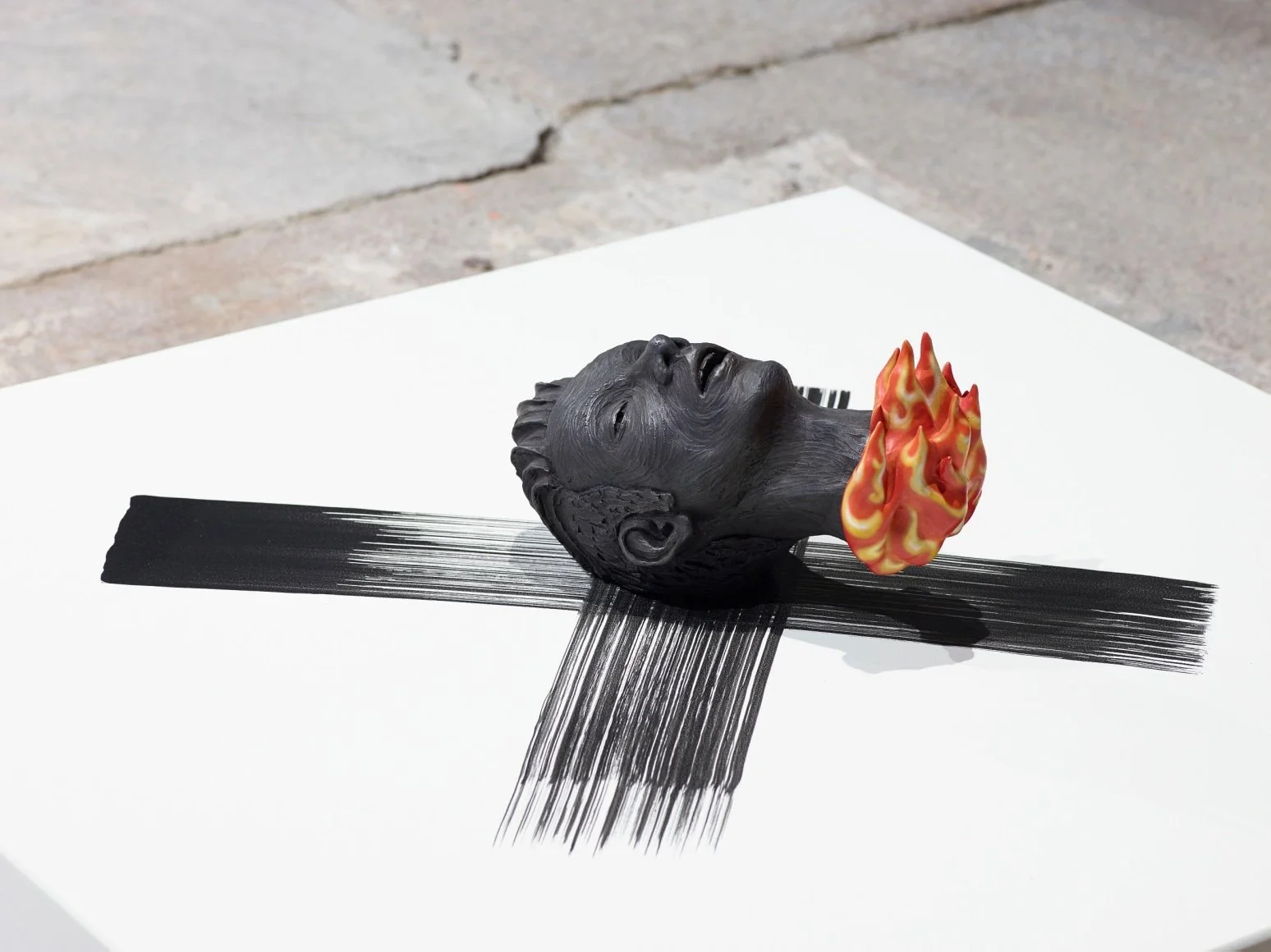Galleri Brandstrup is pleased to present "Lint in the Navel of the World and Abstract Interiors," a new solo exhibition by Fredrik Raddum featuring recent bronze and wood sculptures produced over the past two years. Known for his absurdist, satirical, and profoundly human take on contemporary life, Raddum continues to walk the fine line between humor and existential reflection in this new body of work. The exhibition opens Thursday May 8, at 6 PM.
The title gestures playfully toward philosophy and mythology. In ancient belief systems—from Delphi to Cusco—the “navel of the world” was understood as a sacred center of meaning. Here, Raddum subverts the term, turning the gaze inward to our modern tendency toward self-absorption. The works in the exhibition reflect this friction between a desire for deeper meaning and the mundane, often chaotic nature of our everyday lives. As if through dust on the lens or static in the signal, his sculptures become disruptions in the machinery of modern existence—quirky, poetic glitches that force us to pause.
Lady Elephant
The exhibition includes patinated bronze figures, often painted in detail, and wooden sculptural furniture without clear function. Some pieces lean into quiet joy and observation—such as Loitering in the Night, a sleepwalker with its head turned backward, wandering with wide-open eyes ready to absorb the world. Others, like Mr. Multiple, grapple with inner dissonance: six heads search in different directions, a fractured self digging for answers in the noise of modern life. The mobile-like bronze Umbilicus Mundi dangles body parts in all directions—an emblem of instability, suggesting a loss of center.
A central question in the exhibition emerges: what does it mean to be human in a fragmented world? Drawing inspiration from philosophers like Arne Næss and psychologists like Per Einar Binder, Raddum’s figures embody the tension between autonomy and ambiguity. The bird in Apricitas nests peacefully atop a human head, evoking a stillness that allows room for thought, hesitation, and renewal. This is the space where everything becomes possible—where absurdity and freedom coexist.
With his newest works in wood—crafted entirely in his studio using locally sourced material—Raddum shifts toward a more intimate, tactile presence. The pale surfaces and softened forms contrast with the darker, more dystopian bronze figures. These abstract interiors, while quieter in appearance, continue to resonate with Raddum’s signature wit and existential curiosity.
Ultimately, "Lint in the Navel of the World and Abstract Interiors" invites viewers into a world both familiar and off-kilter, where sculpture becomes a mirror for our contradictions, doubts, and hopes—playfully reminding us that in the absurdity of life, there is space for both laughter and reflection.
BIOGRAPHY - FREDRIK RADDUM
Fredrik Raddum is educated at the National Academy of Art in Oslo, Norway and is known for his figurative sculpture and installation art.
Since ancient times, artists have tried to portray human autonomy trough figurative sculpture, with mimesis as the highest goal. In Raddum’s art, one can see how a contemporary culture with modern technology has moved past the bases of art as a beautified version of reality. Raddum’s art resembles a dystopian cartoon, as a drawn sculpture from his self-created universe.
Like the pioneering pop artists from the sixties USA, Raddum finds his nihilist motives in image banks of mass media and Western culture. However, as we look closer, the dystopian theme comes forth in his art on a thin line between the tragically and the humorous: with his seemingly harmless works, he addresses existentialist and political themes with a sense of humor and a keen eye for the absurd. There is always a subtle, intelligent social satire in mind without obvious display of critical attitude.
In his art, there are also many similarities to the Neo-Pop Artist Jeff Koons, both in his use of shiny materials, and critical themes such as human consumption. As in Koons’ art, Raddum always drops subtle hints encouraging the viewer to think beyond the initial encounter. The main difference between the two artists is how Raddum actually depicts the consequences and fall of man, whereas Koons only flaunts the glossiness of the objects up til the point of brake.
Views on Spontaneous Human Combustion – Head, 2013
In later years, Raddum has taken on the Japanese film. The genera “Kaidan Eiga” is known for is movies tragic endings, which stands in contrast with Raddum’s visual language, who makes them seem more like fun fairytales. Most of Raddum’s artworks, however, revolves around his favorite subject: the late-modern man’s life and identity.
ABOUT GALLERI BRANDSTRUP
Galleri Brandstrup, founded by Kim Brandstrup and Marit Gillespie in 2000 at the historic Madserud Gård in Oslo, was a pioneer in relocating to Oslo's emerging gallery district, Tjuvholmen, in March 2010, where we continue to thrive. Our gallery is renowned for its representation of Nordic masters and influential figures in contemporary Nordic art. We proudly collaborate with some of today’s most innovative and globally recognized artists, including our exclusive representation of Marina Abramović and Joseph Kosuth in Scandinavia, reflecting our close ties with the Sean Kelly Gallery in New York.
Committed to showcasing artists with distinctive conceptual and visual expressions, we host monthly exhibitions year-round in our gallery space. We maintain strong relationships with Norwegian and Scandinavian museums and foundations, leading to numerous significant exhibitions. Notably, we organized the "Mark Quinn" exhibition in collaboration with White Cube Gallery, London, and Kistefos Museum, Norway, in 2011.
Our extensive museum collaborations include Marina Abramović's "Entering the Other Side" at Kistefos Museum (2014), Sverre Bjertnæs at Haugar Vestfold Kunstmuseum (2018), and Per Kleiva's memorial exhibition at Kunstnernes Hus (2018). Recent projects include Steinar Haga Kristensen at Trondheim Kunstmuseum (2021), Lars Ramberg at Bomuldsfabriken Kunsthall (2021), Apichaya Wanthiang at the Munch Museum (2022), Diana Al Hadid at Bomuldsfabriken Kunsthall (2023), Sverre Bjertnæs with Fredrik Værslev at Vestfossen Kunstlaboratorium (2024), and Steinar Haga Kristensen at Kunstnernes Hus (upcoming 2025).
In addition to our gallery exhibitions, we specialize in bringing contemporary art to both public and private spaces. Our focus lies in site-specific and thematically driven installations, often realized in collaboration with in-house or external artists. Our site-specific projects prioritize meticulous planning and consistent regulation throughout the process. These projects entail close cooperation with artists, clients, and, at times, architects, interior designers, and landscapers.
Among our memorable site-specific projects is Joseph Kosuth's "A Monument of Time" at Krona Kultur og Kunnskapssenter in Kongsberg, Norway. It stands as the largest commissioned contemporary art project in Norway, featuring 136 neon elements integrated into the walls as a tribute to the town's history. Another remarkable endeavor is Kjell Erik Killi Olsen's large-scale bronze sculpture "Woman Seeking the Wind" in Vilnius, Lithuania, and Fredrik Raddum's installation "The Sky is the Limit" at Skatt Øst for the Norwegian Ministry of Finance.
In 2014, Galleri Brandstrup, in collaboration with Eli Lilleng Ertvaag, established our sister gallery, BGE Contemporary Art Projects in Stavanger, Norway. For more information, please visit www.bgeart.com.
CONTACT
Galleri Brandstrup
Tjuvholmen allé 5
N-0252 Norway
View Map
Phone +47 22 54 54 54
galleri@brandstrup.no
Opening Hours
Mon: Closed
Tue – Thursday: 12 – 5 pm
Fri – Sat: 12 – 4 pm




